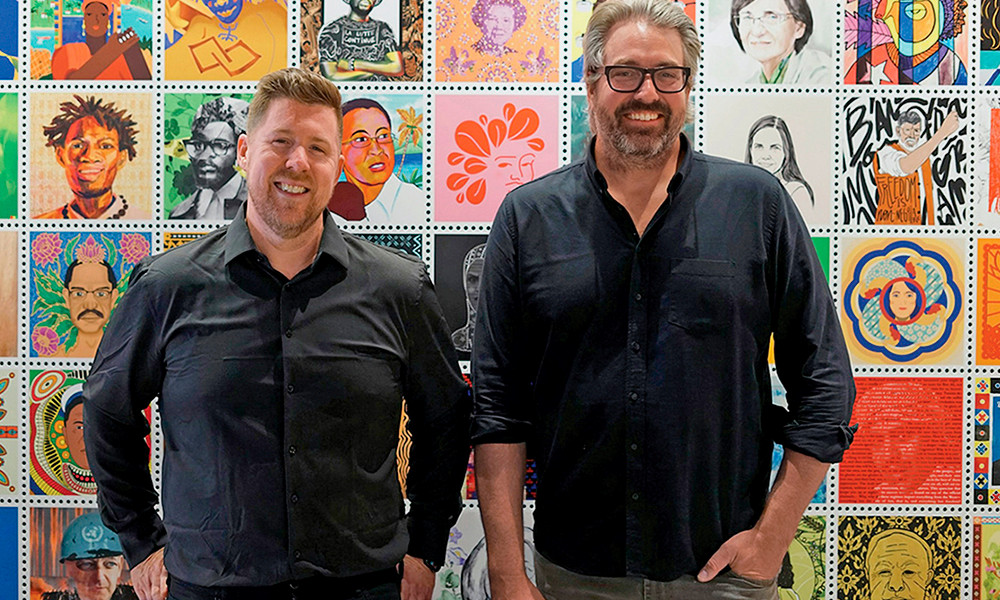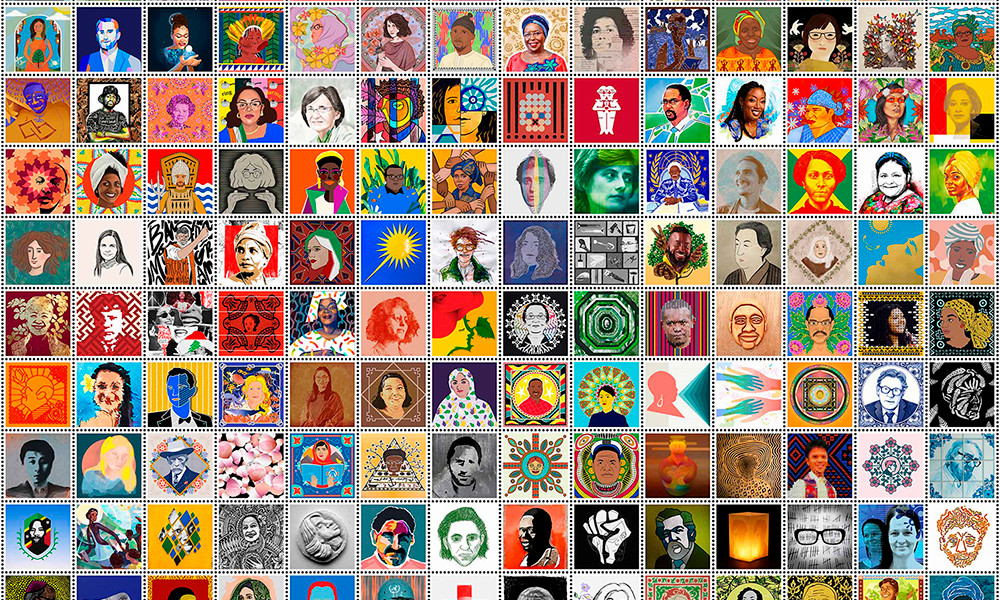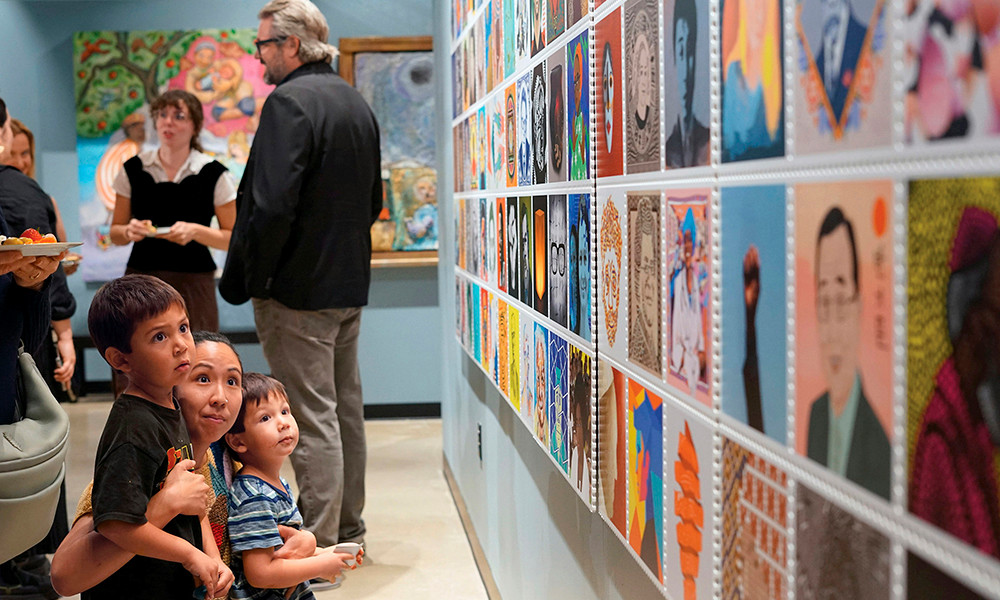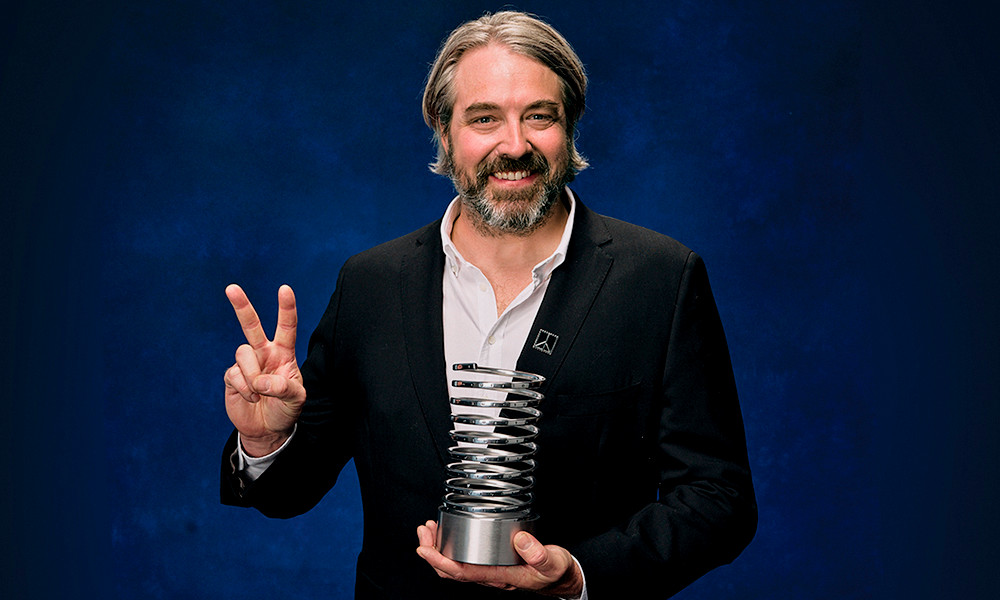Alumni make global impact with portraits of peace
Featured Stories
SUMMARY: Madison classmates Chris Schroeder (’05) and Johnny Selman (’05) teamed up to create Peace Post, an award-winning collection of portraits that champion global peace advocates.
At the Brooklyn-based design studio Selman, Chris Schroeder (’05) and Johnny Selman (’05) are reimagining the postage stamp through their international, award-winning art collection, Peace Post.
The digital stamp collection aims to “shine a light on some of the individuals who stand against injustice and advocate for peace” around the world by “featuring portraits of these heroes, one from each sovereign nation,” according to Peace Post’s homepage.
“The whole idea behind Peace Post is communication, and stamps are really symbolic of communication,” Schroeder said. “Also, they have a rich history of showcasing heroic people and peacemakers. So, we wanted to embrace that a little bit, and in doing that, level the playing field.
“It’s not just Martin Luther King Jr. It’s not just Mother Teresa and folks of that status, but also local heroes and advocates from smaller nations who are less known and doing equally as important work in their communities and in their countries.”

Peace Post launched in 2016 as “a mountain of a project” — 198 portraits representing 198 countries, Selman said.
“It kind of has this bigness, and it has an educational component,” he said. “You’re researching different advocates from each country. You’re learning about the country itself. You’re learning about the artistic traditions of the country. And it’s a wonderful, creative exercise to try and interpret and represent these advocates — that was the beginning of it.”
|
“It’s not just Martin Luther King Jr. It’s not just Mother Teresa and folks of that status, but also local heroes and advocates from smaller nations who are less known and doing equally as important work in their communities and in their countries.” — Chris Schroeder (’05), Peace Post executive producer |
Originally, Peace Post was set to finish in four years, but as the scale of the project and the extensive research involved became clear, the timeline was doubled.
“It was largely done in-house for the first few years,” Selman explained, “and then we gradually started to commission out illustrations to different folks, and a lot of those illustrators were from the country that the advocate was from.”
Over its first eight years, Peace Post successfully collaborated with more than 100 artists from all corners of the world.
“We would do a lot of research and try to come up with a few advocates that we felt were worthy of inclusion in the project,” Schroeder said. “With the ones we were doing ourselves, we made a choice based on the research and discussion within our team. But we found that when we would reach out to an artist from that country, it was nice to present them with options and ask for suggestions.”
Each new installment in the collection demands a hands-on approach that involves stepping away from the computer and working with art supplies in the company’s production room. “One of the things we wanted to do was be inspired by the art of the [advocate’s home] country,” Selman explained. “It was a really rich kind of process. … I just think that’s a wonderful way to connect to a medium and the story in a more tangible way.”
The decision to display the art in postage-stamp form also carries a design benefit — an element of cohesiveness.
“We knew that this was going to be almost 200 illustrations that aren’t really connected by any sort of color palette or style or medium,” Selman said. “So, we needed to have a common through line through all of them, and the stamp border kind of does that. From the very beginning, you see it and you relate it to the project.”

The Peace Post collection is immortalized and widely distributed online, but has also made several in-person appearances at various exhibits.
|
“One of the things we wanted to do was be inspired by the art of the [advocate’s home] country. It was a really rich kind of process. … I just think that’s a wonderful way to connect to a medium and the story in a more tangible way.” — Johnny Selman ('05), Peace Post executive creative director |
The International Peace Museum in Dayton, Ohio, hosted Peace Post’s exhibit premiere. While in Dayton, the team also partnered with a local school group on its inaugural workshop, challenging students to create their version of the stamps and showcasing what peace means to them. Participants of each showcase were gifted a hardcover book providing supplementary information about the Peace Post art.
Since then, Selman and Schroeder have hosted workshops back home at the Brooklyn Public Library and elsewhere around New York City, and hope to host more exhibit displays. When the art is not on display, it is housed in the Selman studio, built to assemble and disassemble with ease as it travels from museums to schools to libraries.
In May, Peace Post won a prestigious Webby Award, which honors excellence on the internet. Nominated in the category of Activism Websites and taking home the win in the category for Cultural Blog, Selman and Schroeder expressed their gratitude. “The Webby was a huge honor, because we’ve worked on this for eight-plus years. We’re learning a lot, and we hear from people that they’ve gained a lot from the project, but to get this kind of affirmation of your efforts well spent,” Selman said.

To further add to the achievement, they received a People’s Voice Webby, which is chosen by the public, independent of the Webby’s executive judges. “I think that’s just the highest honor, honestly, because this project, from conception, was always based online. That is where, globally, you can connect to the most people,” he said.
|
“The hope is that [people] take away the idea that they are not locked into their circumstances, and that there are always opportunities to promote peace and take peaceful action toward righting wrongs in their communities and in society.” — Chris Schroeder (’05), Peace Post executive producer |
As for what’s next for these Dukes classmates, completion of the Peace Post collection and their growing recognition has opened the door to further collaborative efforts. Through new partnerships, they plan to facilitate more focused discussions on regional peace activists.
This October, the exhibit and workshops are coming to Selman’s hometown of Martinsville, Virginia, where art students from Martinsville High School will research advocates and artistic traditions. “The cool thing about this is it’s going to be more regionally focused on advocates, and then the goal there is to display their peace posts along with our exhibit at the Piedmont Arts,” Selman shared.
Similarly, in Richmond, Virginia, they are partnering with the nonprofit Art 180 that will focus on the Jackson Ward neighborhood, a community negatively impacted by the construction of Interstate 95 in the mid-1950s, and the local heroes and advocates who champion its residents.
“We were just so pleasantly surprised at the evolution of it and how it’s found wind in its sails when it comes to focusing more on specific areas of the country and finding these regional heroes,” Selman said. “And I just think that’s more than we could have dreamed of in how this project kind of continues on.”
“The hope is that [people] take away the idea that they are not locked into their circumstances, and that there are always opportunities to promote peace and take peaceful action toward righting wrongs in their communities and in society,” Schroeder said. “It may not be that each individual has to do something, but to go out and support those who are and to rally behind the people who step up and are brave and outspoken.
“Peace is something we have to actively choose to engage in, and I hope that the project represents just a small portion of people who are out there doing that.”
To learn more and to view the complete collection, visit the Peace Post website.
